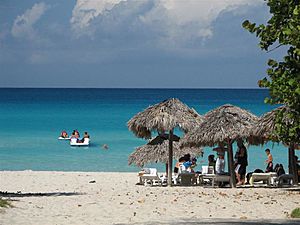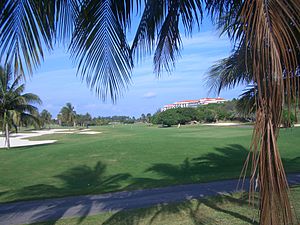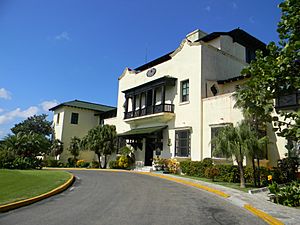Varadero facts for kids
Quick facts for kids
Varadero
Peninsula de Hicacos
|
||
|---|---|---|
|
Municipality
|
||

Varadero beach
|
||
|
||
| Nickname(s):
Playa Azul (Blue Beach)
|
||

The former Varadero municipality (red) within
Matanzas Province (yellow) and Cuba. The rest of Cárdenas municipality is shown in orange |
||
| Country | Cuba | |
| Province | Matanzas | |
| Municipality | Cárdenas | |
| Founded | December 5, 1887 | |
| Established | July 3, 1976 (Municipality) | |
| Area | ||
| • Total | 48 km2 (19 sq mi) | |
| Elevation | 4 m (13 ft) | |
| Population
(2014)
|
||
| • Total | 42,654 | |
| • Density | 566.0/km2 (1,466/sq mi) | |
| Time zone | UTC-5 (EST) | |
| Area code(s) | +53-45 | |
Varadero (Spanish pronunciation: [baɾaˈðeɾo]), also known as Playa Azul (Blue Beach), is a popular resort town in Matanzas Province, Cuba. It is one of the biggest resort areas in the Caribbean. Varadero Beach has been named one of the world's best beaches by TripAdvisor since 2019. In January 2024, it was ranked number 9. Many people visit Varadero for fishing and trips to nearby cities like Matanzas and Cárdenas.
Contents
Geography of Varadero
Varadero is located on the Hicacos Peninsula. This peninsula is a long strip of land between the Bay of Cárdenas and the Straits of Florida. It is about 140 kilometers east of Havana. The peninsula is only 1.2 kilometers wide at its widest point. It is separated from the main island of Cuba by the Kawama Channel.
The peninsula stretches over 20 kilometers northeast. Its tip, Punta Hicacos, is the northernmost point of Cuba. Varadero town has three main avenues and 69 cross streets. At the northeast end, there is a nature reserve with untouched forests and beaches.
Hicacos Point Natural Park
The Hicacos Point Natural Park is a 3.12 km2 (1.20 sq mi) ecological preserve. It was created in 1974 to protect the area. The park includes the 250 m (820 ft)-long Cave of Ambrosio. It also has Mangón Lake, which is home to 31 types of birds and 24 types of reptiles. You can also find the ruins of the La Calavera Salt Works here. This was one of the first salt works built by the Spanish in the New World.
Varadero's Airport
Juan Gualberto Gómez Airport is Varadero's airport. It is located 16 kilometers west of Varadero. This airport is the second most important in Cuba. It handles both international and local flights. The airport was built in the 1990s.
Economy and Tourism
Varadero is a very important economic center in Cuba. It creates over 50,000 jobs, mostly in its more than 52 hotels. Many foreign companies, like Canada's Blue Island and Spain's Meliá and Iberostar, manage these hotels.
In 2017, a record 1.7 million foreign tourists visited Varadero. There are plans to build more five-star hotels. They also plan to add new attractions like a theme park and a shopping mall.
History of Tourism
Tourists started visiting Varadero as early as the 1870s. For many years, it was a resort for wealthy people. In 1915, the first hotel, called Varadero, was built. Later, it was renamed Club Nautico. Tourism grew in the 1930s when American millionaire Irénée du Pont built his large home there. Famous people like Al Capone also stayed in the area.
After the Cuban Revolution in 1959, many mansions were taken from their rich owners. These homes then became museums. In 1960, the Park of the 8000 Cubicles was built. This park allowed all Cubans and foreign visitors to enjoy the beach. People could store their things, use restrooms, and rent swimming gear.
From the 1960s to the 1980s, Varadero became a cultural hub. The central park hosted many concerts, festivals, and sports events. However, in the 1990s, more hotels were built, focusing on all-inclusive tourism. This led to a decline in local cultural life.
Today, Varadero is a free port. It offers many activities like scuba diving, deep-sea fishing, and yachting. It welcomes over 1 million tourists each year. Most visitors come from Europe and Canada.
Climate and Weather Events
Varadero has a tropical climate because it is at sea level. The weather can change due to tropical storms and hurricanes. Trade winds also help to cool the air. The average yearly temperature is 25˚ Celsius (77 ˚F). Summers average 27˚Celsius (80.6 ˚F), and winters average 21˚C (69.8 ˚F). The humidity is usually around 81%. The average yearly rainfall is about 1,400 millimeters (55 inches).
Hurricane Season
Hurricane season starts on June 1 and ends on November 15. September and October are the months when hurricanes are most likely to happen.

More than 150 hurricanes have hit Cuba since 1498. These storms have caused a lot of damage and loss of life. One of the worst hurricanes in 1791 killed about 3,000 Cubans. The most recent major storm was Hurricane Irma. It hit Varadero as a Category 5 hurricane on September 8, 2017. Irma caused major flooding and wind damage. It also destroyed many trees and roofs.
History of Varadero
Varadero was first mentioned in 1555. The area was used as a dry dock for ships. Salt mines on the peninsula provided salt for the Spanish Latin America Fleet starting in 1587.
Varadero officially became a city on December 5, 1887. Ten families from Cárdenas got permission to build their vacation homes there. These first homes, with red wooden roofs, can still be seen along Avenida 1ra.
Varadero became its own municipality (a type of local government area) on July 3, 1976. Before that, it was part of Cárdenas. However, in August 2010, Varadero stopped being a separate municipality. It became part of the Cárdenas municipality again.
Activities and Attractions
Varadero offers many fun activities and places to visit.
Water Activities
- Catamaran Cruises: Many hotels offer boat trips that include snorkeling.
- Dolphin Center: You can visit the Delfinario, a lagoon where you can swim and interact with dolphins. They also have dolphin shows.
- Boating: Hotels can provide kayaks or small boats for guests.
- Fishing: You can find fishing charts at Marlin Náutica y Marinas. They also have equipment for sailboarding and kiteboarding.
- Scuba Diving: Varadero has over 30 dive sites. At Parque Marino Cayo Piedras del Norte, you can see a sunken military ship and an old Soviet aircraft. Ojo de Mégano has an underwater cave.
Other Attractions
- Amusement Park: Visit Centro Todo En Uno for fun rides and games.
- Puente Bacunayagua: This is a famous bridge outside Varadero.
- Hershey Train: An electric train that offers a unique ride.
Events and Festivals
Varadero hosts several exciting events throughout the year:
- Josone World Music Festival: Held every June, this festival features artists from Latin America and other places. Concerts happen in different locations across Varadero.
- Varadero Gourmet Festival: This food festival takes place annually between April and June.
- Harley-Davidson Motorcycle Show: A five-day event for motorcycle enthusiasts is held every February.
- Golf Tournaments: Varadero hosts the Melia Golf Club Cup in October. This is followed by the Los Cactus Varadero Golf Tournament at the Hotel Los Cactus’s Varadero Golf Club.
Sights and Landmarks
- Mansión Xanadu: This building is now a hotel and restaurant. It was once a three-story mansion built by American millionaire Irénée du Pont. After the 1959 revolution, it became a luxury restaurant called 'Las Américas'. The dining room still has its original furniture.
- Parque Retiro Josone: Located on Avenida Primera y Calle 56, this park was created in 1942.
- Museo Municipal de Varadero: This museum on Calle 57 displays furniture and history. It used to be a summer home in the 1920s.
- Santa Elvira Church: This Catholic church was built in 1938 using stones and wood. Its bell tower has a horseshoe-shaped arch with a cross on top.
- Reserva Ecológico Varahicacos: This ecological reserve is at the east end of the peninsula. It covers 730 acres with long trails leading to different caves.
- Cueva Ambrosio: Discovered in the 1960s, this cave has 47 ancient drawings that are over 3,000 years old.
- Cueva de los Musulmanes: This cave was once used as an ancient burial site.
- Playa de Varadero: The famous Varadero Beach.
- Dolphinarium: A place to see and interact with dolphins.
Population and Transportation
Population
In 2007, Varadero had a population of about 20,000 people. Many workers in the tourism industry travel from Cárdenas to Varadero for their jobs.
Transportation in Varadero
- Air Travel: Varadero is served by Juan Gualberto Gómez Airport and Kawama Airport.
- Roads: The main road is Autopista Sur. It starts near the Laguna Paso Malo bridge and goes for about 19.4 kilometres (12.1 mi). The main street in town is Avenida Primera (1ra). It runs along the oceanfront.
- Bus Services: Several bus companies operate in Varadero. Some connect resorts to the town, while others provide public transport within the main town.
Notable People
- José Miranda (b. 1986), a Cuban-born American footballer.
- Leonel "Bebito" Smith (1909–2000), a swimmer.
- J. R. Ramirez (b. 1980), a Cuban-born American actor.
- Amalia Aguilar (1924–2021), a Cuban-born Mexican actress and dancer.
Images for kids
See also
 In Spanish: Varadero para niños
In Spanish: Varadero para niños











